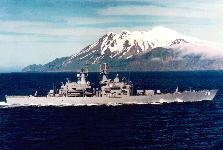



click image for a better view




This was the first class of nuclear-propelled surface warships intended for series production. These ships essentially are nuclear-propelled version of guided missile designs proposed in the early 1960s. To aid in accomplishing their assigned tasks, these ships are equiped with an extensive array of weapons and sensors. They have the older SM-1 series SAM on single arm, Mk13 Mod 3 launchers (fore and aft), two 5 inch guns (fore and aft), anti-ship capability with Harpoon SSMs, the 20mm Close In Weapon System (CIWS) and USW capability with ASROCs, These do not carry TLAMs. Sensors include a 3D air search radar, 2D air search radar, an array of surface search radars and fire control radar systems. They are also equiped with passive electronic surveillance and jamming systems unequaled by any other cruiser in the Navy. These weapons and sensors give them the ability to attack and defend against targets that are over 70 nautical miles away while being able to protect themselfs from close range attacks. Two nuclear reactors provide all the energy required for the propulsion plant and electric generators. The two propulsion plants deliver 70,000 shaft horsepower, allowing sustained speeds in excess of 30 knots (nautical miles per hour) all over the world.
On the 04 September 1998 USS South Carolina completed her service to the active fleet of The United States Navy. Beginning the final Deactivation process, on 04 November 1998, the ship entered Drydock 4 at Norfolk Naval Shipyard. As of 01 October 1998 CGN-36 California was in commission in Reserve (Stand Down) at Bremerton WA at the start of the inactivation cycle.Specifications | |
| Power Plant | Two D2G General Electric nuclear reactors, two shafts, 60,000 shp |
| Length | Overall Length: 596 ft Waterline Length: 570 ft |
| Beam | Extreme Beam: 61 ft Waterline Beam: 60 ft |
| Draft | Maximum Navigational Draft: 32 ft Draft Limit: 23 ft |
| Displacement |
Light Displacement: 10373 tons Full Displacement: 11320 tons |
| Speed | 30 plus knots |
| Aircraft | None |
| Helicopter Landing Capability | Landing area only, no support facilities |
| Armament |
Standard Missiles (MR) ASROC 8 - Harpoon (from two Mk141 quad launchers) 4 - MK 46 torpedoes (from fixed single tubes) 2 - Mk45 5-inch/54 caliber lightweight gun 2 - 20mm Phalanx CIWS |
| Combat Systems |
SPS-40 Air Search Radar SPS-48 3D Air Search Radar SPS-67 Surface Search Radar SQQ-26 Sonar [bow mounted] 1 Mk14 Weapon Direction System 2 Mk74 Missile Fire Control System 1 Mk86 Gun Fire Control System 1 Mk114 ASW Fire Control System 4 SPG-51 Radars SLQ-25 NIXIE SLQ-32 EW system |
| Crew | 40 Officers, 544 Enlisted |
| Unit Operating Cost Annual Average | ~$40,000,000 [source: [FY1996 VAMOSC] |
Ships | ||||||
| Name | Number | Builder | Homeport | Ordered | Commissioned | Decommissioned |
| California | CGN 36 | Newport News | Bremerton | 13 Jun 1968 | 16 Feb 1974 | 01 Oct 1998 |
| South Carolina | CGN 37 | Newport News | Norfolk | 13 Jun 1968 | 25 Jan 1975 | 04 Sep 1998 |



